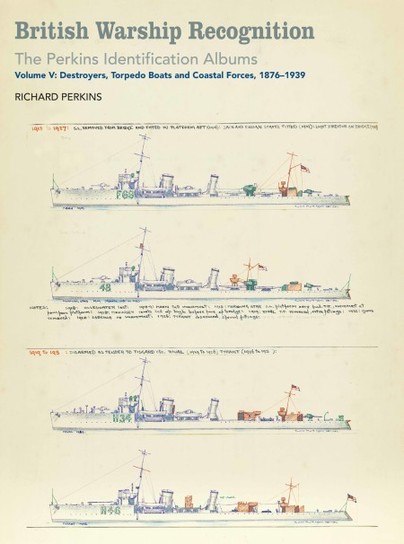
British Warship Recognition: The Perkins Identification Albums, Volume V: Destroyers, Torpedo Boats and Coastal Forces 1876-1939. By Richard Perkins. Seaforth Publishing, Barnsley, 2017, UK Recommended Price £70:00.
Reviewed by David Hobbs
THIS large, heavy book follows the same format as the earlier volumes in the series and is a beautifully printed facsimile of part of the collection of Perkins Albums held in the UK National Maritime Museum at Greenwich. It is by far the largest volume to date and has 309 pages in order to cover the 786 destroyers plus numerous other vessels that are described.
Whilst Destroyers are by far the largest warship group covered, there are also fascinating descriptions and drawings of ‘P’ Boats, ‘PC Boats, Coastal Motor Boats, Motor Torpedo Boats and other coastal craft. Security restrictions prevented Perkins from continuing with his work after 1939 but the period covered in this volume gives considerable insight into the rapid development of the warship types in question. It also makes it possible to identify individual destroyers or patrol vessels from throughout the British Empire during the First World War and the decades immediately before and after it in photographs and to state with reasonable certainty when the image would have been taken.
There is significant RAN interest with coverage which includes HMA Ships PARRAMATTA, HUON, SWAN, TORRENS, WARREGO, YARRA, VENDETTA, VOYAGER, WATERHEN, VAMPIRE, STALWART, SUCCESS, SWORDSMAN and TASMANIA. The drawing of SWORDSMAN on page 188 is a typical example showing her in starboard side profile as she appeared in 1930; sketches on page 186 show the individual funnel markings of SWORDSMAN and her RAN sisters that enabled them to be told apart. There are also sketches of aerial rigs, masts, funnels, alterations and additions carried out to ships throughout their operational lives including, in some cases, such detail as the slightly different styles of forecastle break applied by different shipbuilders and brief service histories. This volume would be an invaluable addition to any collection as a tool for anyone with an interest in identifying and dating ships from the period in question. I have added it to my own library and have enjoyed working my way through the hundreds of drawings which are, as in previous volumes, beautifully reproduced works of art in their own right and worthy of any collection.
With its wealth of data and the high quality printing of literally hundreds of warship drawings, this book deserves positive, even enthusiastic, comment but before ANI members decide to buy a copy, I should comment specifically on that high UK recommended retail price tag. Given the quality of the artwork and the sheer volume of information this book contains I consider the price to be justified. This volume has 119 more pages of drawings and data than the previous one but the unit price has only increased by £10:00. The publisher describes Perkins’ work as ‘monumental’ and given the scale and importance of the resulting volumes, especially this one, I consider that adjective to be fully justified. This latest volume adds considerably to our knowledge of both the subject and the era; I have no hesitation in recommending it.



